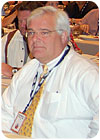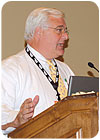Seminar Session: Coping With the Wrath of Mother Nature
The rewards of operating a contracting business in a hurricane zone are tempered by the risk becoming your own client. As the president of New Orleans-based Carriere-Stumm Inc., roofing contractor Rob Stumm Jr. is a veteran of both ends of the business. His presentation on preparing a company to survive a natural disaster focused on the harsh lessons he learned during the hurricane season of 2005. The emergency preparations he employs could benefit any business vulnerable to storm, fire, flood or theft.

The rewards of operating a contracting business in a hurricane zone are tempered by the risk becoming your own client. As the president of New Orleans-based Carriere-Stumm Inc., roofing contractor Rob Stumm Jr. is a veteran of both ends of the business. His presentation on preparing a company to survive a natural disaster focused on the harsh lessons he learned during the hurricane season of 2005. The emergency preparations he employs could benefit any business vulnerable to storm, fire, flood or theft.
On Aug. 27, 2005, Stumm secured his New Orleans home and office and evacuated his family, company computers and records to Tuscaloosa, Ala., to wait out Hurricane Katrina. He wouldn’t reopen the office for two months. In an effort to get his business up and running, Strumm spent that time traveling in a hastily purchased RV between Diamondhead, Miss., Destin, Fla., Atlanta, Houston, Mobile, Ala., and Birmingham, Ala. The obstacles he navigated included the onset of Hurricane Rita and the lack of fuel, electricity, communication tools, manpower and access to banks. To top it off, at one point his RV broke down and was beyond repair. With tireless effort (and a new RV), he was able to build a temporary bunkhouse for employees, make payroll, purchase supplies and equipment and restart his business to help his customers in the recovery effort. Carriere-Stumm billed $975,000 worth of business that September.
Stumm summarized the theme of his presentation with his opening statement, in which he objected to the title of the seminar, “Planning for Disaster.” “You don’t plan for disaster, you prepare,” he said. The steps he recommended consist of more than just jotting down a plan. He indicated these steps could be the difference between realizing a weather-related business opportunity and becoming just another victim of a natural disaster.
Carriere-Stumm has a toll-free Vonage telephone number that can be redirected to ring on up to six different telephones. The feature can be accessed through the Internet with the company’s user name and password. The company’s evacuation plan designates the employee who is responsible for activating the feature, the Internet user name and password, and which employees’ cell phones to redirect the number to in the event of an emergency.
Because storms can knock out cell phones, the company also invested in wireless PC satellite cards for all officers. Internet phone calls, e-mail and text messaging can all be transmitted via satellite.
 Stumm enlists a computer service to back up his company’s main server each week on a “shadow” server in Birmingham. VPN software is installed on the company’s computers to allow them remote server access. The company’s evacuation plan calls for switching to the shadow server 72 hours prior to projected hurricane landfall. It details which employee will facilitate the switch and remove the main server from the office. All employees are instructed to take their computers with them upon evacuation.
Stumm enlists a computer service to back up his company’s main server each week on a “shadow” server in Birmingham. VPN software is installed on the company’s computers to allow them remote server access. The company’s evacuation plan calls for switching to the shadow server 72 hours prior to projected hurricane landfall. It details which employee will facilitate the switch and remove the main server from the office. All employees are instructed to take their computers with them upon evacuation.
Carriere-Stumm maintains an inventory of hurricane preparation supplies, with a record of quantities and location. Some of the equipment on the list includes six 5,550-watt portable generators with wheels, a 150-gallon fuel tank and an electric sump pump. Other supplies include batteries, rope, tarps, motor oil, water hose and extension cords.
Copies of the company emergency evacuation plan, office evacuation plan checklist, and emergency supplies inventory are posted at all of Stumm’s offices and jobsites. His evacuation plan designates which employee all office personnel must notify with their respective evacuation locations and phone numbers. It also names the employee to contact after the storm for instructions. The office checklist provides a detailed account of the office equipment and records that must be removed, and it names the employees responsible for its removal. Current tax, payroll and client records are on the list, as are insurance policies and bank statements.
“Decide you cannot make a wrong decision as long as it’s a quick decision,” asserted Stumm. He ordered the necessary inventory and targeted hospitals and hotels as accounts to stabilize first, based in part on their ready ability to pay for services. In the 12 months following Katrina, Carriere-Stumm’s hurricane-related billings exceeded $21 million, and at that point the rebuilding had not even begun.
Stumm maintains that trust and solid relationships with employees and customers pay off in a disaster situation. “Take care of business just like you take care of family,” he advised.

Rob Stumm Jr.
The rewards of operating a contracting business in a hurricane zone are tempered by the risk becoming your own client. As the president of New Orleans-based Carriere-Stumm Inc., roofing contractor Rob Stumm Jr. is a veteran of both ends of the business. His presentation on preparing a company to survive a natural disaster focused on the harsh lessons he learned during the hurricane season of 2005. The emergency preparations he employs could benefit any business vulnerable to storm, fire, flood or theft.
On Aug. 27, 2005, Stumm secured his New Orleans home and office and evacuated his family, company computers and records to Tuscaloosa, Ala., to wait out Hurricane Katrina. He wouldn’t reopen the office for two months. In an effort to get his business up and running, Strumm spent that time traveling in a hastily purchased RV between Diamondhead, Miss., Destin, Fla., Atlanta, Houston, Mobile, Ala., and Birmingham, Ala. The obstacles he navigated included the onset of Hurricane Rita and the lack of fuel, electricity, communication tools, manpower and access to banks. To top it off, at one point his RV broke down and was beyond repair. With tireless effort (and a new RV), he was able to build a temporary bunkhouse for employees, make payroll, purchase supplies and equipment and restart his business to help his customers in the recovery effort. Carriere-Stumm billed $975,000 worth of business that September.
Stumm summarized the theme of his presentation with his opening statement, in which he objected to the title of the seminar, “Planning for Disaster.” “You don’t plan for disaster, you prepare,” he said. The steps he recommended consist of more than just jotting down a plan. He indicated these steps could be the difference between realizing a weather-related business opportunity and becoming just another victim of a natural disaster.
Carriere-Stumm has a toll-free Vonage telephone number that can be redirected to ring on up to six different telephones. The feature can be accessed through the Internet with the company’s user name and password. The company’s evacuation plan designates the employee who is responsible for activating the feature, the Internet user name and password, and which employees’ cell phones to redirect the number to in the event of an emergency.
Because storms can knock out cell phones, the company also invested in wireless PC satellite cards for all officers. Internet phone calls, e-mail and text messaging can all be transmitted via satellite.

Rob Stumm Jr. of Carriere-Stumm in New Orleans details his company’s struggles to get up and running in the aftermath of Hurricane Katrina.
Carriere-Stumm maintains an inventory of hurricane preparation supplies, with a record of quantities and location. Some of the equipment on the list includes six 5,550-watt portable generators with wheels, a 150-gallon fuel tank and an electric sump pump. Other supplies include batteries, rope, tarps, motor oil, water hose and extension cords.
Copies of the company emergency evacuation plan, office evacuation plan checklist, and emergency supplies inventory are posted at all of Stumm’s offices and jobsites. His evacuation plan designates which employee all office personnel must notify with their respective evacuation locations and phone numbers. It also names the employee to contact after the storm for instructions. The office checklist provides a detailed account of the office equipment and records that must be removed, and it names the employees responsible for its removal. Current tax, payroll and client records are on the list, as are insurance policies and bank statements.
“Decide you cannot make a wrong decision as long as it’s a quick decision,” asserted Stumm. He ordered the necessary inventory and targeted hospitals and hotels as accounts to stabilize first, based in part on their ready ability to pay for services. In the 12 months following Katrina, Carriere-Stumm’s hurricane-related billings exceeded $21 million, and at that point the rebuilding had not even begun.
Stumm maintains that trust and solid relationships with employees and customers pay off in a disaster situation. “Take care of business just like you take care of family,” he advised.
Looking for a reprint of this article?
From high-res PDFs to custom plaques, order your copy today!




